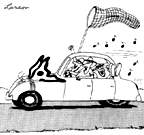
As you search you see some pairs cooperating, but not every pair. For example, some interactions appear as follows.
1) In the first stage the bees successfully foraging on flowers.

2) Eventually, the bees meet each other and exchange information.

3) The bee on the left tells the other bee about the flower that it just visited (cooperates). The information that it supplies correctly identifies that flower.

4) The bee on the right does not provide correct information (defects), and instead tells about some other non-existent flower.

5) This allows the one bee (defector) to forage on the new flower, but sends the other bee (cooperator) on a "wild goose chase." Thus the defector gets the new flower, and retains all of the resources of the old flower, whereas the cooperator has only a part of its original flower.

In other cases, both bees appear to give false information (defect), and neither bee gets any new resources, but they also don't have to share their original flower.

So, why should a bee cooperate at all if it means that it has to share the flower that it found? Your coworker explains that this question is the focus of the lab's current studies and that you should bring yourself up to date on the different theories that could explain this behavior. On the way back to the lab your coworker suggests that she tell you the experiments that they have done so far.

| |